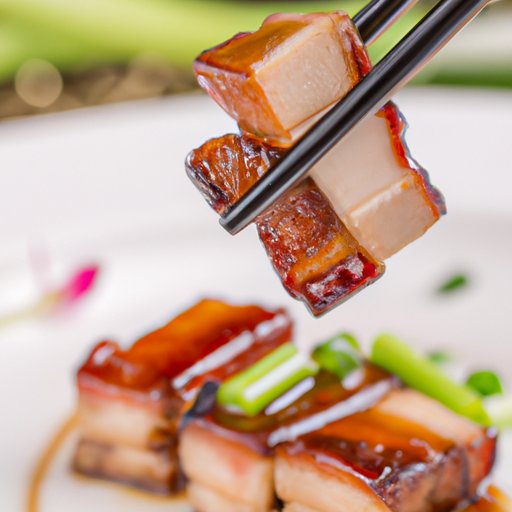Introduction
Cooking pork tenderloin can be a challenge for some people. Knowing exactly how long to cook the meat to achieve the desired level of doneness and flavor is crucial. In this article, we’ll explore different methods for cooking pork tenderloin and provide advice on achieving tender, juicy meat every time.
A Beginner’s Guide: How Long to Cook a Pork Tenderloin
Pork tenderloin is a popular cut of meat that can be cooked in a variety of ways. A basic recipe for pork tenderloin involves seasoning the meat with salt and pepper, and then roasting it in the oven at 425°F for 20-25 minutes. The internal temperature should reach 145°F. It’s always a good idea to use a meat thermometer to ensure the meat is cooked to the desired level.
For beginners, it’s important to remember that pork tenderloin is a lean cut of meat, which means it can easily dry out if overcooked. Keeping the cooking time and temperature in check is crucial to achieve a delicious and moist piece of pork tenderloin.
Perfect Pork Every Time: Mastering the Art of Cooking Pork Tenderloin
Roasting isn’t the only way to cook pork tenderloin. Grilling and sautéing are also popular methods. The key to success with each method is knowing how long to cook the meat for and at what temperature.
When grilling pork tenderloin, preheat the grill to medium-high heat and cook the meat for 15-20 minutes, flipping it once halfway through cooking. Again, use a meat thermometer to check that the internal temperature reaches 145°F.
Sautéing pork tenderloin involves browning the meat in a skillet and then finishing it in the oven. This method takes around 20-25 minutes in the oven at 400°F. The internal temperature should once again reach 145°F.
No matter which method you choose, seasoning the pork tenderloin is key to achieving maximum flavor. Use a combination of herbs and spices, or try a dry rub to add some extra kick.
The Foolproof Technique: Cooking Pork Tenderloin to Perfection
For a foolproof technique, try searing the pork tenderloin on the stovetop before transferring it to the oven. This method will give the meat a crispy crust and juicy interior.
Start by seasoning the meat and then searing it in a hot skillet for 2-3 minutes on each side to get a nice crust. Transfer the skillet to an oven preheated to 375°F and cook the meat for 15-20 minutes until the internal temperature reaches 145°F.
One benefit of this technique is that you can also add some extra flavor by creating a pan sauce from the drippings in the skillet. Simply deglaze the pan with some chicken stock or white wine, and then simmer until the sauce has thickened and reduced slightly.
Slow and Steady Wins the Race: Tips for Achieving Tender Pork Tenderloin
If you’re looking for super-tender pork tenderloin, try marinating the meat before cooking it. The acids in the marinade will help to break down the muscle fibers and result in a more tender bite.
Use a marinade containing citrus juice, vinegar, or yogurt. Add some herbs and spices for flavor and let the meat marinate for at least 30 minutes, or up to 24 hours for maximal tenderness.
Cooking Pork Tenderloin on the Grill: Timing is Everything
Grilling pork tenderloin is a great way to impart a smoky flavor and crispy texture to the meat. However, timing is crucial to avoid overcooked or undercooked pork.
Preheat the grill to medium-high heat and grill the meat for 2-3 minutes on each side, then lower the heat to medium and continue cooking for another 10-15 minutes, flipping occasionally. Again, use a meat thermometer to check that the internal temperature has reached 145°F.
To add some extra flavor, try using a marinade or dry rub on the meat before grilling. A glaze made from honey and soy sauce is also a delicious option.
Avoiding the Dry-Out: How to Cook Pork Tenderloin with Moisture and Flavor
Pork tenderloin can easily dry out during cooking, but there are ways to keep the moisture locked in. Basting the meat with a flavorful liquid during cooking is one such way.
You can use a simple mixture of melted butter and herbs, or try a more complex sauce such as a honey mustard glaze. Brush the sauce onto the meat during cooking, and remember to flip the meat often to ensure even coverage.
Conclusion
Cooking pork tenderloin to perfection doesn’t have to be a daunting task. With the right techniques and a little experimentation, it’s possible to achieve juicy, flavorful meat every time.
Some key takeaways include the importance of using a meat thermometer to check for doneness, seasoning the meat with herbs and spices, and trying out different cooking methods such as grilling and sautéing.
Remember to let the meat rest for 5-10 minutes before slicing to allow the juices to redistribute, and don’t be afraid to get creative with marinades, rubs, and sauces.
